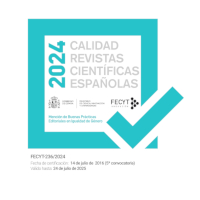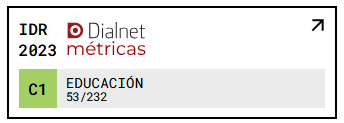Psycometric study of implementation of Internet Addiction Test with Spanish university students
DOI:
https://doi.org/10.18172/con.3067Keywords:
Internet, social nets Works, addiction, university studentAbstract
Internet has experienced in recent years an exponential evolution compared to the society growth. At the same time various problems from a different nature have emerged, associated with different tools created under its wing, such as social networks. One of those problems common to many digital resources is addiction. In order to determine the degree of addiction and problematic usage of youngsters to Internet, Young created the Internet Addiction Test. The purpose of this paper has been to validate whether the instrument, with the appropriate modifications (linguistic, cultural and adaptations to the working tool) can really and effectively measure the degree of addiction to social networks. Just to carry out this and following the guidelines of the work by Watters, Keefer, Kloosterman, Summerfeldt and Parker (2013), it has been studied whether this test is equally valid to measure addiction to social networks. For this it has been made a confirmatory exploratory bivariate analysis to a sample of students (N=362) in grades Pre-primary Education, Primary Education, Social Educator, Education and Business Administration from the University of Cordova. The preliminary result was positive, reflecting that this resource canbe used to determine the degree of addiction or problematic usage to both Internet and social networks.Downloads
References
Alonso, S., Morte, E. y Almansa, S. (2015). Redes sociales aplicadas a la educación: EDMODO. EDMETIC; Revista de Educación Mediática y TIC, 4(2), 88-111. Recuperado de http://www.uco.es/ucopress/ojs/index.php/edmetic/article/view/3964/3823.
Álvarez, M., Castro, P., González-González, C., Álvarez, E. y Campo, M. A. (2016). Conductas disruptivas desde la óptica del docente: validación de una escala. Anales de Psicología, 32(3), 855-862.
American Psichiatric Association. (2003). Diagnostic and statistical manual of mental disorders IV. Text revision. (4ª ed.). Barcelona: Masson.
Ballesta, F. J., Lozano, J., Cerezo, M. C. y Soriano, E. (2015). Internet, redes sociales y adolescencia: un estudio en centros de educación secundaria de la Región de Murcia. Revista Fuentes, 16, 109-130. https://doi.org/10.12795/revistafuentes.2015.16.05.
Bentler, P. M. (2005). EQS 6.1 structural equations program manual. Los Angeles: Multivariate Software, Inc.
Bentler, P. M. y Bonett, D. G. (1980). Significance tests and goodness of fit in the analysis of covariance structures. Psychological Bulletin, 88(3), 588.
Beranuy, M., Chamarro, A., Graner, C. y Carbonell, X. (2009). Validación de dos escalas breves para evaluar la adicción en Internet y el abuso de móvil. Psicothema, 21(3), 480-485.
Bryant, F. B. y Satorra, A. (2012). Principles and practice of scaled difference chi-square testing. Structural Equation Modeling: A Multidisciplinary Journal, 19(3), 372-398. DOI: http://doi.org/10.1080/10705511.2012.687671.
Carbonell, X. y Oberst, U. (2012). Las redes sociales no son adictivas. Aloma, 33(2), 13-19.
Carbonell, X., Fuster, H., Chamorro, A. y Oberst, U. (2012). Adicción a Internet y móvil: una revisión de estudios empíricos españoles. Papeles del Psicólogo, 33(2), 82-89.
Chang M. K. y Law S. P. (2008). Factor structure for Young’s Internet Addiction Test: A confirmatory study. Computers in Human Behaviour, 24(6), 2597-2619. DOI: http://doi.org/10.1016/j.chb.2008.03.001.
Chang, W-L. y Lee, C-Y. (2013). Trust as a learning facilitator that affects students’ learning performance in the Facebook community: An investigation in a business planning writing course. Computers & Education, 62, 320-327. DOI: http://doi. org/10.1016/j.compedu.2012.11.007.
Cheng, J. y Chang, C. (2006). Using computers in early childhood classrooms: teachers’ attiudes, skills and practices. Journal of Early Childhood Research, 4(2), 269-288.
Cheung, C. M., Chiu, P.-Y. y Lee, M. K. O. (2011). Online social networks: why do students use Facebook? Computers in Human Behavior, 27, 1337-1343. DOI: http:// doi.org/10.1016/j.chb.2010.07.028.
Costello, A. B. y Osborne, J. W. (2005). Best practices in exploratory factor analysis: Four recommendations for getting the most from your analysis. Practical Assessment, Research and Evaluation, 10(7), 1-9.
Cress, U. y Kimmenrley, J. (2008). A systemic and cognitive view on collaborative knowledge bulding with Wikis. International Journal of Computer Supported Collaborative Learning, 3(2), 105-122. DOI: http://doi.org/10.1007/s11412-007-9035-z.
Del Barrio, A. y Ruíz, I. (2014). Los adolescentes y el uso de las redes sociales. International Journal of Developmental and Educational Psychology, 1(3), 571-576.
Delgado-Rico, E. D., Carretero-Dios, H.C. y Ruch, W. (2012). Content validity evidences in test development: An applied perspective. International Journal of Clinical and Health Psychology, 12(3), 449-460.
Durán, M. y Guerra, J. M. (2015). Usos y tendencias adictivas de una muestra de estudiantes universitarios españoles a la red social Tuenti; La actitud positiva hacia la presencia de la madre en la red como factor protector. Anales de Psicología, 31(1), 260-267. DOI: http://doi.org/10.6018/analesps.31.13158301.
Echeburúa, E. y De Corral, P. (2010). Adicción a las nuevas tecnologías y a las redes sociales en jóvenes: un nuevo reto. Adicciones, 22(2), 91-96. Recuperado de http://www.adicciones.es/index.php/adicciones/article/view/196/186.
Elosua, P. y Zumbo, B. D. (2008). Coeficientes de fiabilidad para escalas de respuesta categórica ordenada. Psicothema, 20(4), 896-901.
Fernández-Villa, T., Alguacil, Almaraz, A., Cancela, J. Mª, Delgado-García, M., Rodríguez-Martín, M., Jiménez-Mejías, E., … Valero-Juan, L. y Martín, V. (2015). Uso problemático de internet en estudiantes universitarios: factores asociados y diferencias de género. Adicciones, 27(4), 265-275. Recuperado de http://www.adicciones.es/ index.php/adicciones/article/view/751/720.
Gialamas, V., Nikolopouiou, K. y Kutromanos, G. (2013). Student teachers’ perceptions about the impact of Internet usage on their learning and jobs. Computers & Education, 62, 1-7. DOI: http://doi.org/10.1016/j.compedu.2012.10.012.
Gómez, M., Ruíz, J. y Sánchez, J. (2015). Aprendizaje social en red. Las redes digitales en la formación universitaria. EDMETIC, Revista de Educación Mediática y TIC, 4(2), 71-87. Recuperado de http://www.uco.es/ucopress/ojs/index.php/edmetic/article/ view/3963/3822.
González, C. y Muñoz, L. (2016). Redes sociales: su impacto en la Educación Superior- Caso de estudio Universidad Tecnológica de Panamá. Campus Virtuales, 5(1), 84-90.
Griffiths, M. D. (2013). Social Networking Addiction: Emerging Themes and Issues. Journal Addiction Research & Therapy 4(5), e118. DOI: http://doi.org/10.4172/2155- 6105.1000e118.
Guedes, E., Sancassiani, F., Carta, M. G., Campos, C., Machado, S., King, A. L. S. y Nardi, A. E. (2016). Internet Addiction and Excessive Social Networks Use: What About Facebook? Clinical Practice and Epidemiology in Mental Health: CP & EMH, 12, 43-48. DOI: http://doi.org/10.2174/1745017901612010043.
Hu, L. y Bentler, P. (1999). Cutoff criteria for fit indexes in covariance structure analysis: conventional criteria versus new alternatives. Structural. Equation. Modeling: A Multidisciplinary Journal, 6(1), 1-55. DOI: http://doi. org/10.1080/10705519909540118.
Lam, J. T., Peng, Z-W., Maü, J-C. y Jing, J. (2009). Factors associated with Internet addiction among adolescents. CyberPsychology of Behaviour, 12(5), 551-555. DOI: http://doi.org/10.1089/cpb.2009.0036.
Laru, J., Näykki, P. y Järvelä, S. (2012). Supporting small-group learning using multiple web 2.0 tools: a case study in the higher education context. The Internet and Higher Education 15, 29-38. DOI: http://doi.org/10.1016.jhedu.2011.08.004.
Lloret, S., Ferreres, A., Hernández, A. y Tomás, I. (2014). El análisis factorial exploratorio de los ítems: Una guía práctica, revisada y actualizada. Anales de Psicología, 3, 1151-1169. DOI: http://doi.org/10.6018/analesps.30.3.199361.
Lorenzo-Seva, U. y Ferrando, P. J. (2006). FACTOR: A computer program to fit the exploratory factor analysis model. Behavior Research Methods Instruments & Computers, 38(1), 88-91.
Malita, L. (2011). Social media time management tools and tips. Procedia Computer Science, 3, 747-753. DOI: http://doi.og/10.1016 / j.procs.2010.12.123.
Marín, V., Sampedro, B. E. y Muñoz, J. M. (2015). ¿Son adictos a las redes sociales los estudiantes universitarios? Revista Complutense de Educación, 26, 233-251. DOI: http://doi.org/10.5209/rev_RCED.2015.v26.46659.
Muñoz, G. (2010). Las redes sociales: ¿formula mediática contra la soledad y el aburrimiento? Revista Latinoamericana de Ciencias Sociales, Niñez y Juventud, 8(1), 51-64.
Neukrug, E. y Fawcett, R. (2014). Essentials of Testing and Assessment: A Practical Guide for Counselors, SocialWorkers, and Psychologists. Stamford, CA: Cengage Learning.
Osorio, M. J., Molero, M. M., Pérez, Mª C. y Mercader, I. (2014). Redes sociales en Internet y consecuencia de su uso en estudiantes universitarios. International Journal of Development and Educational Psychology, 1(3), 585-592.
Othman, M. S., Mohamad, N., Yusuf, L. M., Yusof, N. y Suhaimi, S. (2012). An analysis of social network categories: social learning and social friendship. Procedia Social and Behavioral Sciences, 56, 454-460. DOI: http://doi.org/10.1016/j. sbspro.2012.09.676.
Ozgur, H., Demiraley, T. y Demiralay I. (2014). Exploration of problematic Internet use and loneliness among distance education students. TOJET, Turkish online Journal of Distance Education, 15(2), 75-90.
Parra, V., Vargas, J. I., Zamorano, B., Peña, F., Velázquez, Y., Ruíz, L. y Monreal, O. (2016). Adicción y factores determinantes en el uso problemático de internet en una muestra de jóvenes universitarios. Edutec-e, Revista Electrónica de Tecnología Educativa, 56, 60-73. Recuperado de http://www.edutec.es/revista/index.php/ edutec-e/article/view/741/Edutec_n56_Parra_Vargas_Zamorano_Pe%C3%B1a_ Velaquez_Ruiz_Monreal.
Pontes, H. M., Caplan, S. E. y Griffiths, M. D. (2016). Psychometric validation of the generalized problematic internet use. Scale 2 in a Portuguese sample. Computer in Human Behaviour, 63, 823-833. DOI: http://doi.org/10.1016/j. chb.2016.06.015.
Pontes, H. M., Griffiths, M. D. y Martins, I. (2014). Internet Addiction and Loneliness Among Children and Adolescents in the Education Setting: An Empirical Pilot Study. Aloma, Revista de Psicología, Ciencias de la Educación y Deporte, 32(1), 91-98. Recuperado de http://revistaaloma.net/index.php/aloma/article/view/225/146.
Puerta-Cortés, D. X., Carbonell, X. y Chamorro, A. (2013). Análisis de las propiedades psicométricas de la versión en español del Internet Addiction Test. Trastornos Adictivos, 14(4), 99-104.
Rideout, V. (2012). Social media, social life: how teens view their digital lives. San Francisco: Common Sense Media.
Sánchez, E., Cantero, R. y Rodríguez, M. C. (2016). Adicción a Internet en futuros profesores. Un estudio de caso con alumnado universitario. INNOEDUCA, 25(1), 46-53. DOI: http://doi.org/10.20548/innoeduca.2016.v2i1.1063.
Satorra, A. y Bentler, P. M. (1994). Corrections to test statistics and standard errors in covariance structure analysis. En A. von Eye y C. C. Clogg (Eds.), Latent variables analysis: Applications for development research (pp. 399-419).Thousand Oaks, California: Sage.
Schmid, J. y Leiman, J. (1957). The development of hierarchical factor solutions. Psychometrika, 22(1), 53-61.
Schultz, F., Utz, S. y Göritz, A. (2011). Is the medium the message? Perceptions of and reactions to crisis communication via twitter, blogs and traditional media. Public Relations Review, 37, 20-27. DOI: http://doi.org/10.1016/j.pubrev.2010.12.001.
Valdivieso, C. E. (2013). Efecto de los métodos de estimación en las modelaciones de estructuras de covarianzas sobre un modelo estructural de evaluación del servicio de clases. Comunicaciones en Estadística, 6(1), 21-44.
Watters, C. A., Keefer, K. V., Kloosterman, P. H., Summerfeldt, L. J. y Parker J. D. A. (2013). Examining the structure of the Internet Addiction Test in adolescents: A bifactor approach. Computers in Human Behaviour, 29(6), 2294-2302. DOI: http:// doi.org/10.1016/j.chb.2013.05.020.
Downloads
Published
How to Cite
Issue
Section
License
The authors retain copyright of articles and authorize Contextos Educativos. Revista de Educación the first publication. They are free to share and redistribute the article without obtaining permission from the publisher as long as they give appropriate credit to the editor and the journal.
Self-archiving is allowed too. In fact, it is recommendable to deposit a PDF version of the paper in academic and/or institutional repositories.












